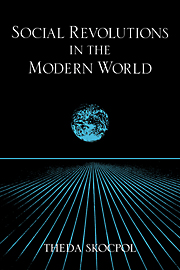Book contents
- Frontmatter
- Contents
- Acknowledgments
- INTRODUCTION
- I DOING MACROSCOPIC SOCIAL SCIENCE
- II MAKING SENSE OF THE GREAT REVOLUTIONS
- III A DIALOGUE ABOUT CULTURE AND IDEOLOGY IN REVOLUTIONS
- IV FROM CLASSICAL TO CONTEMPORARY SOCIAL REVOLUTIONS
- 9 What makes peasants revolutionary?
- 10 Rentier state and Shi'a Islam in the Iranian Revolution
- 11 Explaining revolutions in the contemporary Third World
- 12 Social revolutions and mass military mobilization
- CONCLUSION
- Index
10 - Rentier state and Shi'a Islam in the Iranian Revolution
Published online by Cambridge University Press: 05 June 2012
- Frontmatter
- Contents
- Acknowledgments
- INTRODUCTION
- I DOING MACROSCOPIC SOCIAL SCIENCE
- II MAKING SENSE OF THE GREAT REVOLUTIONS
- III A DIALOGUE ABOUT CULTURE AND IDEOLOGY IN REVOLUTIONS
- IV FROM CLASSICAL TO CONTEMPORARY SOCIAL REVOLUTIONS
- 9 What makes peasants revolutionary?
- 10 Rentier state and Shi'a Islam in the Iranian Revolution
- 11 Explaining revolutions in the contemporary Third World
- 12 Social revolutions and mass military mobilization
- CONCLUSION
- Index
Summary
The recent overthrow of the Shah of Iran, the launching of the Iranian Revolution between 1977 and 1979, came as a sudden surprise to outside observers – from the American friends of the Shah, to journalists and political pundits, and to social scientists including those, like me, who are supposed to be “experts” on revolutions. All of us have watched the unfolding of current events with fascination and, perhaps, consternation. A few of us have also been inspired to probe the Iranian sociopolitical realities behind those events. For me, such probing was irresistible – above all because the Iranian Revolution struck me in some ways as quite anomalous. This revolution surely qualifies as a sort of “social revolution.” Yet its unfolding – especially in the events leading to the Shah's overthrow – challenged expectations about revolutionary causation that I developed through comparative-historical research on the French, Russian, and Chinese Revolutions.
“Social revolutions” as I define them are rapid, basic transformations of a country's state and class structures, and of its dominant ideology. Moreover, social revolutions are carried through, in part, by class-based upheavals from below. The Iranian Revolution seems to fit this conception. Under the old regime, the Shah ruled through an absolutist-monarchical military dictatorship, styling himself a cosmopolitan Persian King in the 2,500-year-old image of Cyrus the Great. Iran's dominant class, ostentatiously pro-Western in its cultural style, consisted of state bureaucrats, foreign capitalist investors, and domestic capitalists closely tied by patronage and regulation to the state machine.
- Type
- Chapter
- Information
- Social Revolutions in the Modern World , pp. 240 - 258Publisher: Cambridge University PressPrint publication year: 1994
- 4
- Cited by



